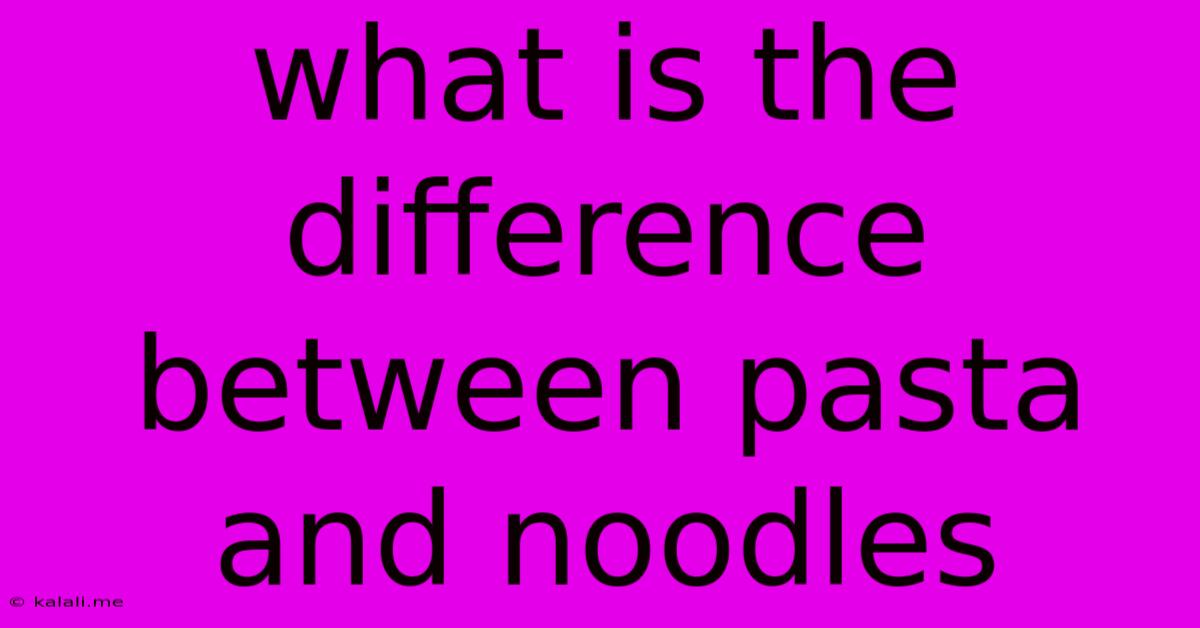What Is The Difference Between Pasta And Noodles
Kalali
May 21, 2025 · 3 min read

Table of Contents
Pasta vs. Noodles: What's the Difference?
Are pasta and noodles the same thing? While they often appear similar – long, thin strands of dough served in various dishes – there are key distinctions between pasta and noodles. This article delves into the core differences, exploring ingredients, textures, and cultural origins to help you understand these culinary staples.
Pasta and noodles are both carbohydrate-rich food items, typically made from flour and water, offering a versatile base for countless dishes. However, the specific ingredients, preparation methods, and regional variations contribute to their distinct identities.
Key Differences: Ingredients and Preparation
The primary difference lies in the ingredients and their preparation. Pasta, traditionally, is made from durum wheat semolina and water. This specific type of wheat contributes to pasta's characteristic firm texture, even after cooking. While variations exist, using semolina is a defining characteristic of authentic pasta. The dough is then kneaded, shaped, and often dried before cooking.
Noodles, on the other hand, boast a wider range of ingredients and preparation techniques. They can be made from a variety of flours, including wheat flour, rice flour, buckwheat flour, and even bean flour. This diversity results in noodles with varying textures, colors, and flavors. Some noodles are egg-based, further enhancing their texture and richness. The preparation methods also vary widely, from simple hand-rolled dough to extruded shapes achieved using specialized noodle-making machines.
Texture and Cooking Methods
The difference in ingredients directly affects the texture. Pasta tends to have a firmer, chewier bite even when cooked al dente (to the tooth). This is largely due to the use of durum wheat semolina.
Noodles, however, exhibit a broader spectrum of textures. Some are delicate and tender, while others are chewy and resilient, depending on the flour used and the preparation methods. Rice noodles, for instance, are known for their delicate texture, while wheat noodles can be quite firm.
Regional Variations and Culinary Traditions
The cultural origins and culinary traditions further distinguish pasta and noodles. Pasta is strongly associated with Italian cuisine, although variations exist worldwide. Specific shapes and sauces are deeply embedded in Italian culinary history and regional traditions.
Noodles, meanwhile, represent a far broader global phenomenon. Different cultures have their own unique noodle variations, reflecting their specific ingredients and culinary practices. From ramen in Japan to pho in Vietnam and lo mein in China, the diversity of noodle dishes showcases the adaptability and global appeal of this food.
Beyond the Basics: Exploring Specific Examples
To illustrate the differences more clearly, let's examine some specific examples:
- Spaghetti (Pasta): Made from durum wheat semolina and water, characterized by its long, thin strands and firm texture.
- Ramen Noodles (Noodles): Often made from wheat flour, sometimes with egg, exhibiting a range of textures depending on the specific recipe and preparation.
- Rice Noodles (Noodles): Made from rice flour, known for their delicate texture and often used in Southeast Asian cuisine.
Understanding the subtle differences between pasta and noodles requires appreciating the diversity of ingredients, techniques, and cultural influences that shape these culinary staples. While both offer delicious and versatile culinary options, their distinct characteristics ultimately define their individual identities.
Latest Posts
Latest Posts
-
What Is Gor For Movie On Blood Secnes
May 23, 2025
-
Can You Sync Plague Inc To Pc
May 23, 2025
-
Latex Change Math Font To Sans Serif
May 23, 2025
-
How To Make White Empty Space Into Shape Illustrator
May 23, 2025
-
How To Remove A Destroyed Lug Nut
May 23, 2025
Related Post
Thank you for visiting our website which covers about What Is The Difference Between Pasta And Noodles . We hope the information provided has been useful to you. Feel free to contact us if you have any questions or need further assistance. See you next time and don't miss to bookmark.